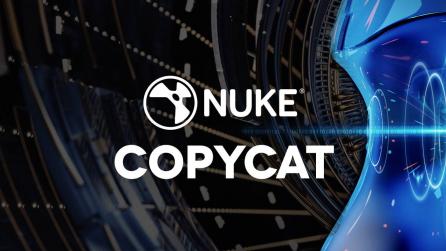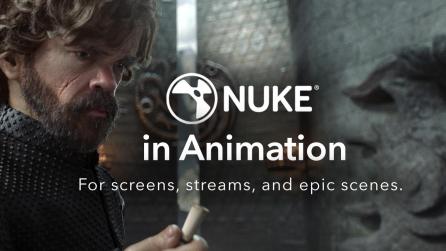Creating an efficient animation pipeline for your studio
Over the past few years, the popularity of animation has been quickly increasing. While it’s no new form of entertainment—the first animated feature was created in the early 1900s—its escalating prominence comes not just from consumer demand but also from the effects COVID-19 had on the media and entertainment industry.
With film crews not being able to get on set or in studios, the industry turned to animation—a form of entertainment that allows creative teams and voice-over artists alike to work remotely, and still produce the high-quality content audiences demand.
Animated content is on the rise for adults and families, so it’s important that creative teams have the right tools they need. While everyone knows Nuke as the industry-standard compositing toolset for films and TV shows, its stronghold in animation is perhaps lesser-known.
With Nuke’s powerful color management and robust multi-channel workflows, combined with Nuke’s ability to work in large formats at high resolutions, users can enjoy a level of fine-tuning and adjustment across all render layers and passes, offering unparalleled depth and precision. Nuke is also continually adapting to the changing climate, and with it, ensuring that artists and studios can use this advanced toolset to create animation for streaming, TV and film.
From short-form animation like REALTIME’s photorealistic game trailer for Game of Thrones: Winter is Coming, to feature-length epics like Sony Pictures Imageworks, Spider-Man: Into the Spider-Verse—Nuke is an essential part of the animation pipeline. In this article, we take a look at how Nuke is used far and wide to create both CG and 3D animation.

Node-based compositing for animation
To keep up with increasing industry demands, even the smallest visual effects studios are scaling up, attempting to complete work more efficiently in shorter timelines. With this growing pressure, it’s important artists can create the highest quality work while having the creative freedom to push boundaries and still deliver their shots on time.
Nuke's toolset is flexible, designed to allow teams to work collaboratively at scale. Its visual, node-based workflow is artist-friendly and makes organizing scripts easy, improving productivity and allowing for work to be shared across teams. At the same time, Nuke exposes full control over every aspect of the image to the user, providing artists power over every pixel, so they can achieve the exact look they are after.
With all animation and CG-heavy VFX projects, one of the biggest challenges that studios face is reducing costly and time-consuming re-rendering. The iterative process of animation often requires that 3D scenes need to be rendered multiple times as creative decisions are refined—Nuke can help significantly cut down on this time and expense.
With its extensive toolset and multi-channel workflow, Nuke gives users the ability to modify color, lighting and composition of shots, quickly and easily. This enables artists to make multiple iterations and refine the look of the shot, without needing to re-render. This is a huge time and cost saver for studios working on complex animation.

What’s more, Nuke has numerous tools available for making corrections in the comp, further reducing the need for re-rendering. Its extensive paint tools and true 3D environment makes generating DMPs for environments, or patching and reprojecting broken 3D renders simple. Additionally, the powerful, GPU-enabled nodes in NukeX allow for complex modifications such as retiming and defocusing. VectorBlur is a prime example of this as it gives artists the ability to precisely dial in the motion blur of a CG render, as can be seen in Hype Studios’ use of Nuke on Angry Birds: Bubble Trouble.
Nuke's deep compositing toolset also extends the flexibility of Nuke, enabling artists to work more efficiently on animation projects. The tools allow for elements to be rendered without predetermined holdouts, further reducing the need to re-render when making content changes. This enables multiple elements in a shot to be worked on and rendered independently and in parallel, with Nuke able to combine all the elements correctly in depth. Deep workflows are especially helpful when combining CG objects and volumetric effects within the composite, helping to cut down on expensive rendering of atmospheric images.
Step into a world of animation
DIGIC, a Hungary-based animation studio, uses Nuke on their complex CG projects for this reason. Their use of deep compositing, combined with Nuke’s high level of control and the ability to make adjustments in the composite, helps them achieve the photo-real look seen in their animatic game trailers.
One of their more recent projects was the Assassin’s Creed Valhalla trailer, the release of which created quite a buzz not just in the VFX industry, but around the world. This wasn’t just for the anticipation of the game itself, but the awe-inspiring visuals seen in the trailer.
Nuke can be used in any part of an animation pipeline, from look development right through to final pixels. It can be used to quickly iterate a look, the multi-channel toolset making it easy to make changes to grading and atmosphere as well as lighting and shaders. This allows artists to work in a flexible and agile way when refining the aesthetic of a project. Once the look has been approved, changes can then be pushed back to 3D departments for the final renders.
Nuke’s powerful finishing tools then come into play, allowing artists to add depth of field, atmospherics, light wraps, glows, film grain and so much more, giving the finished shot a photo-real cinematic quality which is strived for on a project like DIGIC’s Assassin’s Creed Valhalla game trailer.
Automation and creativity
With animation projects increasing in complexity and deadlines tightening, it’s integral that artists have a way to automate certain tasks as well as a way to reuse tools, scripts, and assets wherever possible.
Nuke comes equipped with an open and flexible architecture. With a Python API and C++ at its core, artists can experience a high level of customization and automation. This integrated Python support is highly valuable when it comes to the repetitive tasks so often faced with animation production—especially in episodic.
With Nuke's Python API, almost any repeatable task can be automated, allowing pipeline teams to write Python scripts for batch processing tasks such as conforming renders, applying color corrections, setting up templates, or rendering Nuke scripts—all without ever having to open Nuke's UI. By using Python to automate this repetitive work, Nuke can be fully integrated into complex animation pipelines, so artists can focus on making awe-inspiring images.
Nuke also enables sections of scripts to be packaged up as Gizmos—reusable groups of nodes that can be reused by other artists. This enables artists to create complex setups and effects which can be bundled into user-friendly tools and reduce complexity.
Gizmos are a great way to share tools across projects or studios, ensuring the look of the show stays consistent. This was the approach that Sony Pictures Imageworks used for some of their stylized, comic-book look for Spider-Man: Into the Spider-Verse, enabling them to have a consistent look across the film without overwhelming the artists with complex tools.
For more advanced effects, the BlinkScript node allows artists to write their own image processing operations inside of Nuke, and create their own CPU or GPU-enable effects which can be used in the nodegraph. Using BlinkScript, artists can quickly prototype custom tools, before developing these into fully-fledged C++ nodes.

This is continued through the ability to set up key shots and quickly propagate any changes across sequential shots using Toolset and Presets in Nuke. The time-saving presets enable artists to set and save tailored node parameters for effects to use across multiple projects. Meanwhile, the node tools let users automate their workflows by creating grouped configurations of nodes for specific tasks.
Artists can save common setups and apply them quickly and easily while still being able to tweak each project as needed, saving time, and reducing the need to repeat work.
Nuke gives artists unparalleled control over their shots, and this freedom allows for a more dynamic way of working. All this together provides an efficient workflow for artists and allows them to create high-quality animation content with ease.
Collaborative workflows
As with any production, ensuring good collaboration and communication across not only your team but any other departments and studios is a vital part of creating animation content.
Working with hundreds of different artists around the world on a small budget, for the team at NightWheel using Nuke was a no-brainer. The creators wanted to make an animation that adults could enjoy, resulting in La Noria, a darkly beautiful and terrifying short film, with the look of a cinematic feature.
The team wanted to give the animation the feel of an expensive cinematic film—their Lighting and Compositing teams being able to harness the full power of Nuke to help them achieve this. Nuke's role in the lighting and compositing pipeline allows for greater flexibility and the ability to work much faster. Tasks that would have taken months using a 3D-only process, could be completed in almost no time using Nuke. This enabled the team to create the beautiful, cinematic look they were aiming, whilst working with artists from all over the globe—something that has proved itself to be a vitally important part of making animation this year.
LiveGroups also play an important part in any collaborative workflow, even more so when it comes to animation. This powerful workflow makes it easy for multiple artists to work on a single shot at the same time. With LiveGroups' robust versioning system, artists can work simultaneously on different parts of a shot, without getting in each other's way or any confusion about who is using the latest updates.

Plus, once a particular look or effect has been defined, it can be wrapped in a LiveGroup and rolled out across a whole project. If any changes need to be made, they can be made once, in the LiveGroup master script, and everyone using that LiveGroup can easily pick up the new version.
What’s more, artists have complete control over the LiveGroups and the ability to apply overrides as necessary, as well as the ability to keep track of all updates being made by the team. By using LiveGroups as a way to make master scripts, whether you're an artist or a supervisor, you’ll have an overview of all the different shots that are being worked on at any given moment.
Nuke makes sharing work between teams and departments easy. Whether it’s editable Nuke scripts artists can share or custom tools in Gizmos for specific tasks, the compositing tool saves creative teams valuable time and ensures consistent results. With Python at its core, studios can easily integrate Nuke into their pipeline, allowing for smooth data flow between Nuke and other applications. It also ensures everyone on the team is working in a predictable environment and has access to the correct assets.
Nuke’s collaborative workflow allows artists and teams to communicate comments, identify errors early and encourages artists to collaborate, enabling them to make better work faster when creating animation content.
Animating the future
While animation production is only set to increase in the forthcoming years, creative teams can be safe in the knowledge they have a toolset that can keep up with its ever-increasing demands. Nuke offers efficiency and control for those creating this type of content.
With 2021 looking like it may be the year of animation, it’ll be interesting to see just how this animation is being produced and what this is set to do to the industry in the future.
Right now, the quality is only set to get better, and Foundry’s Nuke is a key part of animation workflows, aiding artists in their creativity and efficiency when creating animation content.
Interested in making animated content?
Check out our animation solutions


